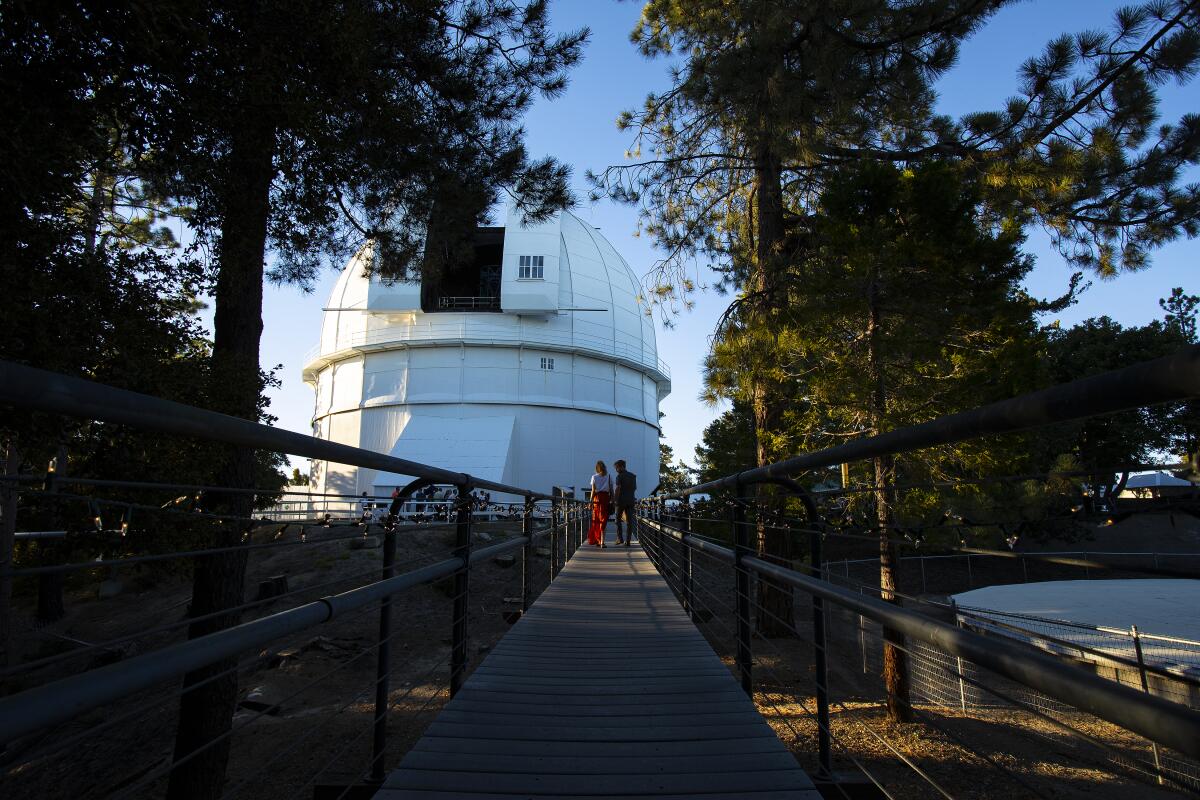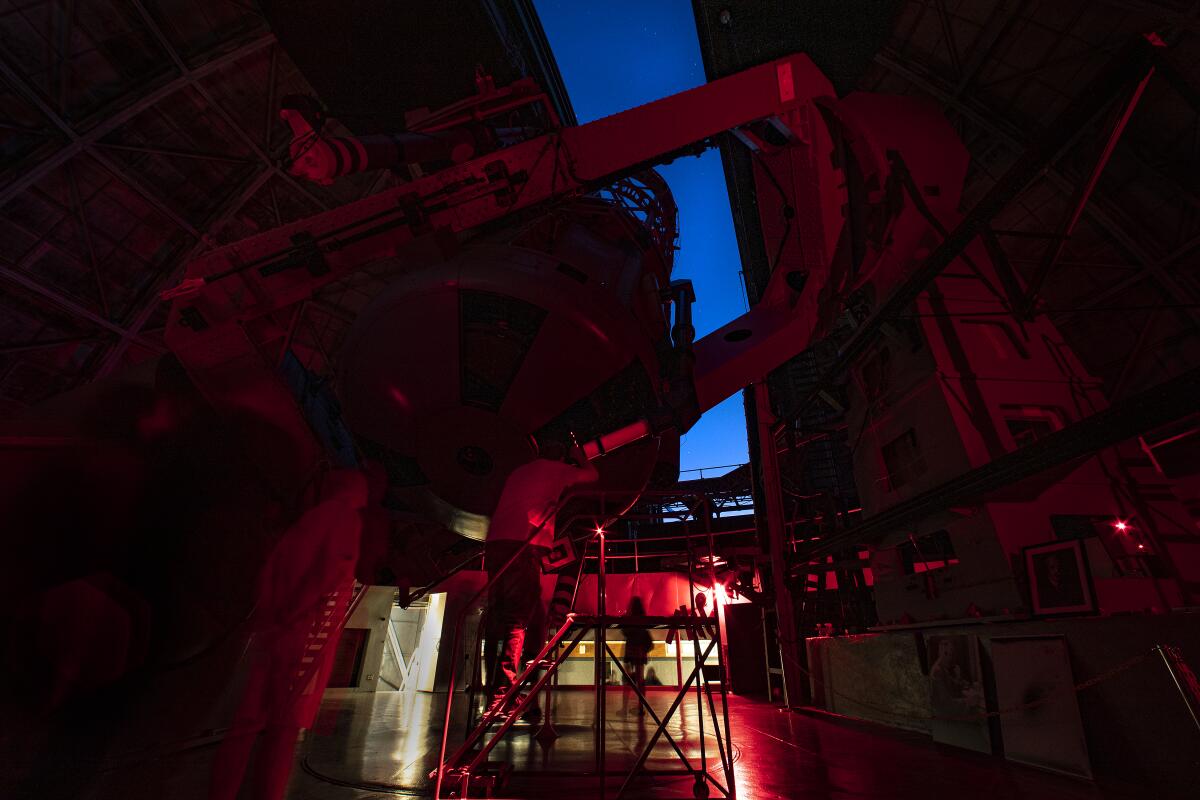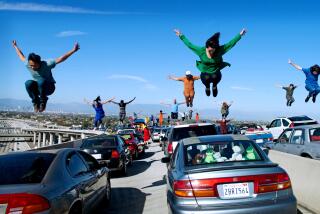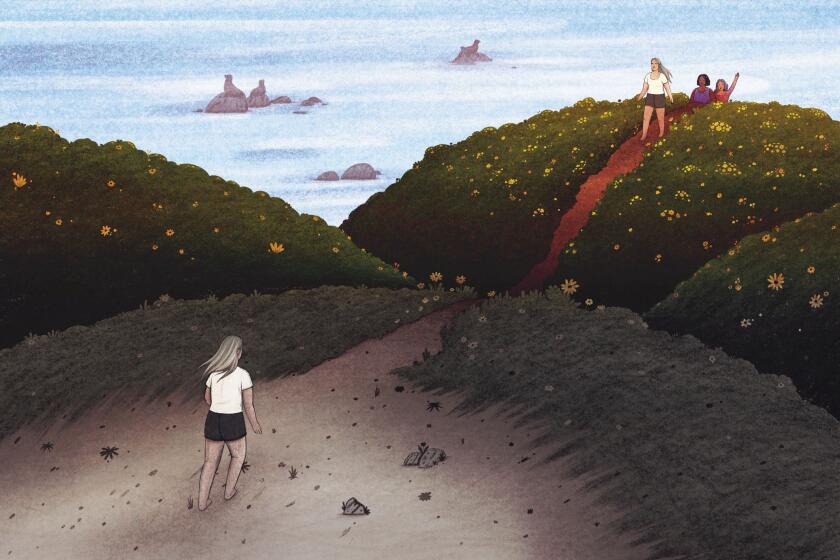Postcard From L.A.: In the moon glow of Mt. Wilson, go find your place in the cosmos

We are standing in the very spot where mankind first kissed the cosmos.
Do I have your attention yet?
On a summer Saturday night, Mt. Wilson beckons, open to the public and a thousand times more tempting than any sticky-floored multiplex.
You want worlds far, far away? Well, come take a peek.
Because when you study it a little — and I study all things just a little — you find that Mt. Wilson is the Fenway Park of 20th century astronomy, a thrilling place where contrarians helped change the plot lines of human existence.
Perched so splendidly a mile above the basin, Mt. Wilson remains L.A.’s stiff upper lip: Wistful. Resilient. Smells of pine needles (all our best places smell a little of pine … dugouts, campsites, world-class observatories).
You just want to know what you can see up here, right? Is it an inspired place to bring a first date? Can you get a decent sandwich?
You kind of want to bed down for the night here amid the oaks and the pines, as so many star-gazing geniuses have, as they studied the whys and hows of distant galaxies. In many ways, Mt. Wilson is their Bethlehem … a cradle of scientific oh-my-Gods.
It was right here that they figured out where we are on the celestial map, first measured the Milky Way, discovered that the universe is expanding, moving away, shunning us.
Naturally, you want to know more — for nearly every philosophy insists that we are at the center of things.
Turns out not, and you could easily argue that this 100-inch telescope and its roster of cutting-edge astronomers were as life-altering as the Old Testament.
The Elvis, the Jesus, the Galileo of this monument was a fella named George Ellery Hale, a brilliant manic-depressive who built this dome and its telescopes, then invited the world – including Albert Einstein and Edwin Hubble — to come up to play.
You may or may not have heard of Hale. But he was a techie rock star for the region, particularly Pasadena, turning it into a research hub. Without Hale, there would be no Caltech. Without Hale, there would be no Jet Propulsion Laboratory.
Without Hale, there might not be a Pie ‘n Burger (now do I have your attention?). I mean, talk about star power.
OK, maybe that’s going a little far, but that’s what Hale did up here, he went deep. In the quiet of these pines and oaks, he rejiggered everything we once knew about the universe.
Despite its significance, Mt. Wilson was forgotten for a while, a victim of the city lights that ruined its darkroom ambience, of bigger scopes, and then of philanthropic evolution — the Carnegie Institution pulled out 30 years ago.

Now, thanks mostly to donations and volunteers, this diamond on the hill is enjoying a bit of a renaissance, with public viewings through the 60- and 100-inch telescopes, an option only since 2015. The observatory also invites the public to frequent concerts and lectures, in what is becoming the second golden age of space travel.
Indeed, in many ways, Mt. Wilson was a stepping stone to the Apollo mission for NASA, and today it stands as a rallying point for L.A. residents to gaze out at the moon, which if all goes well might be our 51st state.
China, Japan, Russia, India, all have shown an interest in exploring the moon as well, and maybe a unified approach would be wise — a fruitful and diplomatic meeting of the minds. But a space race is good for everyone, yielding technological advances and benefits no STEM program can ever match.
A space race is science on steroids.
But you just want to know what you can see up here, right? Is it an inspired place to bring a first date? Can you get a decent sandwich?
Yes to all of that. Public viewings are plentiful. The views of the basin itself are breathtaking. To lend a little romance to the place, occasional chamber concerts take place on Sundays in the giant dome, a surprisingly acoustic hall.
After all, Einstein himself once said: “I live my daydreams in music.”
Meanwhile, monthly guest speakers discuss such things as 100-yard-wide holes on the moon that might make it permanently habitable.
“I think it’s a very exciting time to be a moon enthusiast,” says the night’s lecturer, Laura Kerber of JPL, who is working on a proposal to send a rover down the moon tubes at the next landing, scheduled for 2024.
Stay tuned.
To get a sense of this telescope, completed in 1917 and for the next 30 years the best in the world, note that it can reveal stars so faint that they are no brighter than a candle flickering 8,000 miles away.
Last weekend, a cross-section of 200 students, parents and space geeks lined up to stare out at just that sort of thing: NGC 6210, a violent dying star 6,500 light years away.
When we were done marveling at that, we lined up at telescopes set up by volunteers from the L.A. Astronomical Society to look at the laugh lines on the moon.
“This truly is a magical place,” says Sam Hale, the grandson of George Hale and the chair of the facility’s board of trustees, as he bops around to greet visitors on this Saturday night.
“I think there’s a Pavlovian twist to astronomy,” says visitor Ray Blumhorst. “With astronomy you don’t always get the reward you’re hoping to see, but if you keep at it … .”
Magic, magic, magic.
Location, location, location.
Sure, Mt. Wilson may have been compromised by the ember-like glow of the L.A. basin, but it still benefits from the incredible weather. The air up here is so still, experts say, that it takes the trademark twinkle-twinkle out of the stars. It is as if the wrinkled atmosphere has been tamed by a giant flat iron.
That’s good, you know, when you’re looking for a clear-eyed view of the primordial universe. Or when you’re trying to zoom in on the footprints to the future.
Or merely find your little cubbyhole in the cosmos.
ESSENTIALS
Mt. Wilson Observatory is located in the San Gabriel Mountains, a 30- to 40-minute drive off the 210 Freeway (take the Angeles Crest Highway exit, then head up the hill).
It is open every day from 10 a.m. to 5 p.m., on weekends from 8:30 a.m. The grounds and museum are free. Tours are $15. Chamber concerts in the dome, requiring tickets, are held on occasional Sundays. Telescope options vary, including individual and group tours. The best deal is probably the $25 public lectures, which include a telescope session.
Sandwiches and souvenirs are available at the Cosmic Café, open weekends from 10 a.m. to 5 p.m.
Parking requires a daily or annual Adventure Pass. Daily passes can be purchased for $5 at the café.
More to Read
Sign up for The Wild
We’ll help you find the best places to hike, bike and run, as well as the perfect silent spots for meditation and yoga.
You may occasionally receive promotional content from the Los Angeles Times.











